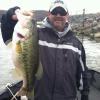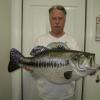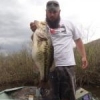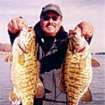Just My Take on the Drop Shot Fishing Technique
I am no expert by any stretch of the imagination, but I have grown fond of the Drop Shot technique in my short, six-season fishing journey. I found this technique to be a very productive method to catch fish in a variety of states. In my first outing for fishing for smallmouth bass ever, I hooked and caught three smallmouth bass on three consecutive casts. It is the only method that has done this for me to date, and from the shore to boot. At the very least, I can share with you what I have learned through trial, error, and experience (which isn't much).
As a method of catching fish, I believe the Drop Shot, as many bass anglers call it, has been around for a very long time. In its most basic form, it consists of having a weight at the end of the line with the hook a set distance above it.
Basic Drop Shot Diagram
Here is a generic set up:
As previously noted, the weight that gets this rig to the bottom is attached at the end of the line and the hook is placed above it. Although weight of the sinker can be of just about any shape, there are some that are available that have a clip at the top of the weight that can be quickly attached to the line. It is not necessary, but it can be a convenient to use. A teardrop shaped weight with a clip for the line is used in the photo above.
Rod Selection
You don't need a Drop Shot specific rod. A medium-light to medium-powered rod with a moderate to extra-fast action, and a length ranging from 6'3" on up to just over 7' should work for you for now, unless you plan to fish heavier cover. If you find drop shotting to your liking, you can then opt to go with a Drop Shot specific rod of your choice. As a rule of thumb, a longer rod will enable you to have more line control, which is a plus when using the drop shot.
Unfortunately, many anglers perceive the drop shot to be an exclusively finesse (fishing with lighter line, and smaller baits) technique. I do not limit myself to such a narrow view. I believe that the drop shot technique can be successfully employed not only in finesse but also heavier situations. One would simply have to adjust the rod and line to suit the environment.
Reel Selection – Spinning or Casting?
The decision to use a spinning or casting reel is up to you. I will use either, depending on the conditions I face.
I prefer spinning reels (a size 20 or 2500 reel is an excellent choice) if I am going to face light cover, use lighter line and a lighter weight (1/8 oz. or 3/16 oz.). This is because they require less work on my part to give the bait a better vertical drop than a baitcast reel ever could. I realize it is minor, but it is a major peeve of mine to have to strip line off when using 1/8 oz. or 3/16 oz. weights just to produce a vertical descent of the bait. This is not an issue with a spinning reel. A vertical descent is achieved without any extra effort when the bail is kept open.
With that said, casting reels can also be used. Even a Barbie pole can get it done for drop shotting! I will not hesitate to use a baitcast reel if I were going to fish cover that required the use of heavier line, heavier weights, and larger baits.
Drop Shot Weight and Type
A 3/16 - 1/4 oz weight is a good starting weight. Going any lighter might make it harder for you to read what is going on until you get experience. As for the shape, I like to use either the teardrop (like the QuickDrops sinkers. They are my favorite.) or cylindrical shape and prefer the former as my first choice. I have not experimented with other shapes. When facing windy conditions, strong currents, or if you have to fish a greater depth, you might want to consider using a heavier weight. Update: I no longer go out of my way to purchase drop shot specific weights. I use coiled pencil lead that I cut with special pliers that river anglers use. It is far more economical. A typical bag of ten 1/4oz weights (2.5 oz.) is about $3.50 give or take a few pennies. If I were to buy a pound of ¼ oz. drop shot weights, it would cost me $22.50! A pound of lead coil costs about $4.00. The math is simple. In addition, with the pencil lead, I can cut my lead to any size that I want and on the fly.
Line
Because you are drop shotting, lighter line is preferred if the cover you are fishing allows it. Use a heavier line if the cover dictates it. The conditions I generally face allow me to use six-pound fluorocarbon line. I usually use Seaguar's Invizx or Cabela’s house brand. Seaguar’s Invizx line is surprisingly limp and that is what I like about it. It is very manageable on spinning gear, which is something that cannot be said about other fluorocarbon lines whose stiffness can make it a pain to use on a spinning reel.
I know that some also like to use braid. I know the benefits of braid and am not against it and maybe someday I’ll use it with a fluorocarbon leader. Given the amount of sensitivity my rod and line already provide me, I just don’t have a need to take it up another notch to braid for the depths I typically fish, which is usually no more than 25’. If you plan to fish greater depths, braid may very well be the ticket. The enhanced sensitivity braid provides should be helpful.
Baits
I keep an open mind when it comes to the baits I use. Many types of baits can be used. The general rule of thumb is a tendency to use smaller baits since we are "finesse" fishing (translates to downsizing in general). The length of a typical drop shot bait usually ranges from 3" - 4.5". However, this is not set in stone.
Senkos, Sniper Snubs and Bolts, Roboworms, Reaction Innovations Flirts, Baby Brush Hogs and Tubes can be used. Think out of the typical angler’s zone. Do not limit yourself to using just a worm.
Here is a picture of a smallmouth bass I caught on a longer Roboworm hoping for a bigger smallie. Bless its little heart. The Roboworm is nearly as long it is!
Hook, Knot, and Rigging
I prefer to use size 1 or 2 (mostly size 2) Owner Mosquito or Gamakatsu Split Shot/Drop Shot hooks. If I am fishing a grassy area in which grass can catch the exposed hook, I opt for the Owner Down-Shot hook, which is in essence a mini version of an EWG (extra wide gap) worm hook. Naturally, if you plan to drop shot much larger baits, you might need to go up in hook size.
When tying the line to the hook to fish the drop shot, many anglers like to use the Palomar knot.
Tie the Palomar knot as you usually would but do so with an extra long tag end. After the knot has been tied, position the hook with the point facing skyward and feed the tag end through the eyehook from the top. Next, tie, or if you have a drop shot specific weight, attach the weight to the tag end.
TIP: To ensure that the point of the hook will face up after tying the Palomar knot, hold the hook so that the point is facing skyward in one hand. Then, initiate tying the knot by inserting the line through the hook’s eye from the top (the point’s side). If you start the Palomar knot by inserting the line the other way, the hook will be oriented point down upon completion.
The two most commonly used ways to place the bait onto the hook when fishing the drop shot rig are to hook the bait through its nose, as shown in the first picture in this article and wacky rigged, or through the middle of the bait as shown below.
A “Wacky-Rigged” 3” Senko
Tag End Length (Distance from the hook to the weight)
The best way to figure this out is to experiment. I have had success with the tag end being as short as 4-6" to nearly but not quite 24”. Because drop shot method is not limited to a purely vertical presentation, a longer leader is an option if you wish to work it like a Texas or Carolina rig (i.e., dragging it on the bottom from spot to spot). When fishing from the shore and as I do most of the time, a longer tag end will enable you to keep the bait off the ground with the shallow angle that results from a long cast and being on the bank. For a more vertical presentation, a shorter distance from the hook to the bait could work. Another influencing factor is the depth at which the fish are staying. You might need to adjust your tag end accordingly to get the bait into the fish’s strike zone.
Imparting Action and Giving Life to the Lure
Despite my initial perception of working a bait on a drop shot rig, I have learned that it is not all about jiggling and wiggling the bait to death. An angler can indeed work the bait this way, but I can tell you from personal experience that wiggling and jiggling the bait to death (continuously) has accounted for the fewest number of catches. By no means am I saying to not wiggle and jiggle it to death. It is however, just one method that can be effective on certain occasions.
So what should one do in addition to the wiggling and jiggling tactic?
Keep the weight on the bottom for the most part and leave enough slack in the line to let the bait sink/float/suspend on its own accord. For lack of a better term, I call that slack, “semi-slack.”
Then, when you think the bait is near the bottom lift/twitch the rod just enough to move the bait a little (without moving or minimizing the movement of the weight on the bottom) and repeat. In effect, what you are doing is working a semi-slack line, which in turn, imparts action and life to the bait. No hits? Repeat if you wish, or add a little dead sticking to the mix or, drag your bait to the next spot. All are good choices. The dragging of the weight from one spot to the next also imparts life and action to the lure and can help to draw a strike. Working a semi-slack line and dead sticking have usually very effective and productive for me. Give it a try and see if it does the same for you.
Not sure what the bait will do? Find shallow water and drop your bait down. The depth should be one where you can see all the way to the bottom. Once the weight is on the bottom, let your bait fall by lowering your rod. After the lure hits the bottom, raise the rod’s tip enough to bring the lure up a little while keeping some slack in the line, and do your best to keep the weight in place. Watching this will give you an idea of what will likely be happening when you are not able to see the bait with your own eyes. Visualizing what the bait is doing when I can’t see it helps me to focus on what I am trying to do, and that is catching fish.
Concerned about not being able to feel the bite on this semi-slack line if you are using fluorocarbon or braid? Let me put you at ease. It is not an issue. Either of those lines combined with a sensitive rod is more than adequate to feel the bite when the line has a bit of slack.
The Strike or Hit
The strike or hit can vary depending on the activity level of the fish, the quality of your set up to a certain extent, and the line you are using. More sensitive rods do a better job of transmitting what is going on to you. I have had the blessing of drop shotting with my Berkley Cherrywood Rod, which is decent and not too shabby, but comparing it to my Lamiglas Certified Pro Drop Shot rod is something else. Here is my analogy:
If the Cherrywood rod provides stereo sound to me while watching a DVD movie, the Lamiglas rod gives me the sound in THX and Blu-Ray for the mental image, for the full cinema experience. The latter rod is not necessary to enjoy drop shotting, but it makes it a lot easier to feel and detect the subtle strikes.
The line you use can also influence the feel of the strike. My experience working with both mono and fluorocarbon is that the latter always seemed to give me a better picture. We all know now that although FC line can have as much or more stretch than a comparable monofilament line, it is likely that its density still enables it to beautifully transmit information from the end of our line, to the rod and to our hands. We all know how well braid transmits data back to the angler too so I don’t think I need to elaborate further.
The hit or strike can feel like:
A) A mushy tug or tick, which could translate to a complete inhalation of your bait or the fish attacking the lure from the hook's side.
A nibble or nibbling, that transmits vibrations through the line to you. Sometimes you can see or feel the line vibrate through your semi-slack line. More sensitive rods tell you this much better and more clearly. I believe when the hit is like this (my best guess anyway as I visualize the strike), it is possible that the fish might have taken the lure from the side opposite the hook and the nibbling/vibrations you feel is the fish taking in the bait into its mouth, eventually getting to the hook.
C) Bam! An aggressive hit and it's on!
The Hook Set
For one and three, just reeling up the slack and adding enough tension to make the line taut is sufficient for most cases to drive the light wire hook home. For case two, you have to wait until the fish gets to the hook and then do as mentioned above. If you don't, you will pull the lure from the fish's mouth. Since it didn't get to the hook, there is no way the fish can get hooked.
I have written this based on the experience I gained from drop shotting. Take it for what it’s worth, an opinion at best. I will close by giving you a final warning:
WARNING: Drop Shotting is as addictive as it is effective.
Good luck and go get’em!
Islandbass
Review of My First Season Using the Drop Shot Technique
The Drop Shot technique has been so effective for me that in my first season learning and using it, it has accounted for 100% of the smallmouth bass and about 70% of the largemouth bass I have caught in that season, I caught a lot, the most ever!!! And here is the thing that makes this even sweeter. They were all caught from the shore. No, this is not a testament to my skills, but a testament to the effectiveness of the Drop Shot technique.




